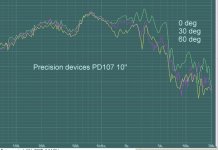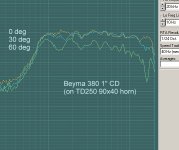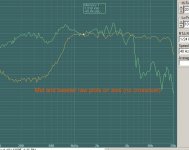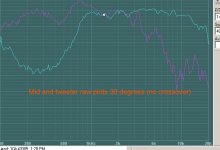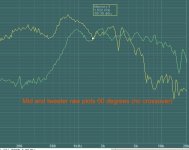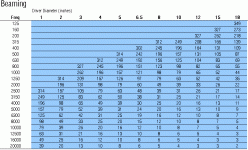I've been looking for HE drivers to achieve reference levels with good on and off axis response. Eminence Delta 12LF appeals most as a mid at the moment, due to its good xmax, surprisingly smooth response and relatively low cost. Some Q's:
* this driver is designed for bass but is there any reason not to use it as a mid driver?
* theMagnum 12 HO driver appears similar, although it has a copper shorting ring and seems the cheapest to have this - any comments on this driver
* is there another driver I should consider that might be better?
* should I be concerned about the slight peak at the top end?
I want a 12" mid for the balance of bang for buck performance, controlled off axis response and not being too big.
Here is the response:
http://editweb.iglou.com/eminence/eminence/pages/products02/speakers/del12lf.htm
Magnum response:
* What is the highest xo point that is likely suitable for this driver?
Could I use a notch filter to tame the peak and cross at 2.5k? Or should I cross as low as possible, say more like 1.7k?
Regarding a tweeter, I'm considering 2 options:
1) A planar or ribbon tweeter
2) Vifa DXT25 - the non ring radiator version 90.5 db 1w1m & 140w power handling >>> I'd add a waveguide to achieve +6db eff on the low end
This would be a digital active speaker with 8th order slopes crossing to a 12" vented sub at 80 Hz.
* Is lobing a problem with speakers such as this, or is it reduced with waveguides and larger drivers with higher directivity?
* this driver is designed for bass but is there any reason not to use it as a mid driver?
* theMagnum 12 HO driver appears similar, although it has a copper shorting ring and seems the cheapest to have this - any comments on this driver
* is there another driver I should consider that might be better?
* should I be concerned about the slight peak at the top end?
I want a 12" mid for the balance of bang for buck performance, controlled off axis response and not being too big.
Here is the response:
An externally hosted image should be here but it was not working when we last tested it.
http://editweb.iglou.com/eminence/eminence/pages/products02/speakers/del12lf.htm
Magnum response:
An externally hosted image should be here but it was not working when we last tested it.
* What is the highest xo point that is likely suitable for this driver?
Could I use a notch filter to tame the peak and cross at 2.5k? Or should I cross as low as possible, say more like 1.7k?
Regarding a tweeter, I'm considering 2 options:
1) A planar or ribbon tweeter
2) Vifa DXT25 - the non ring radiator version 90.5 db 1w1m & 140w power handling >>> I'd add a waveguide to achieve +6db eff on the low end
This would be a digital active speaker with 8th order slopes crossing to a 12" vented sub at 80 Hz.
* Is lobing a problem with speakers such as this, or is it reduced with waveguides and larger drivers with higher directivity?
Hi Paul,
I think you really need the off axis response for the 12" driver, and that of the ribbon/planar tweeter.
This question goes back to your beaming Q's you posted.
I've attatched a plot of my 10" mids raw response (no eq/crossovers) As you can see it starts to beam around the 1.2KHz mark, and it matched the dispersion of my horn tweets at 1.3KHz...... Also note the breakup at 3K that needs to be avoided too... I crossed 24dB/oct. , considered eq'ing the breakup out aswell, but I can't hear it ..
You 12" should start to beam a little lower than this.....
Not much help, but.....
Rob.
I think you really need the off axis response for the 12" driver, and that of the ribbon/planar tweeter.
This question goes back to your beaming Q's you posted.
I've attatched a plot of my 10" mids raw response (no eq/crossovers) As you can see it starts to beam around the 1.2KHz mark, and it matched the dispersion of my horn tweets at 1.3KHz...... Also note the breakup at 3K that needs to be avoided too... I crossed 24dB/oct. , considered eq'ing the breakup out aswell, but I can't hear it ..
You 12" should start to beam a little lower than this.....
Not much help, but.....
Rob.
Attachments
Eminence Delta 12LF appeals most as a mid at the moment, due to its good xmax, surprisingly smooth response and relatively low cost
Seeing as you're going to be using it as a midrange driver, xmax isn't much of an issue. Drivers of this size used from 200-300hz up will be fine with as little as maybe 1-2mm xmax, there's nothing wrong with having more, just don't put undue emphasis on it.
It does seem to have a smooth response on-axis, but I think it might start to roll off too early off-axis to be able to mate well with a planar/ribbon tweeter.
TBH, I'd look at some Pro 10" drivers for the midrange. They'll extend into the highs a little further, while still being capable enough to provide reference levels.
Regarding a tweeter, I'm considering 2 options:
1) A planar or ribbon tweeter
2) Vifa DXT25 - the non ring radiator version 90.5 db 1w1m & 140w power handling >>> I'd add a waveguide to achieve +6db eff on the low end
You'll want to make sure the off-axis response of the mid and tweeter are as close as possible at the crossover point. This might make it hard for you to find a planar/ribbon that will cross low enough, yet be dynamic enough/have low enough distortion to keep up with the midrange...
How do you like the PD107, Rob?. What do you have above/below it?
The new 10" and 12" PD Neodymium drivers look quite nice, maybe you should have a look at them, Paul.
Precision Devices
The new 10" and 12" PD Neodymium drivers look quite nice, maybe you should have a look at them, Paul.
Precision Devices
maybe this
I was looking at the kappa pro wich seems to have good hf extension and just a little breakup.....
http://editweb.iglou.com/eminence/eminence/pages/products02/speakpro/kap12.htm
Maybe you could cross higher with that one?
I was looking at the kappa pro wich seems to have good hf extension and just a little breakup.....
http://editweb.iglou.com/eminence/eminence/pages/products02/speakpro/kap12.htm
Maybe you could cross higher with that one?
Hmmm polar response ... seems that info is more difficult to find.
I am now thinking that if I went with the Magnum driver, it probably would have better bass than my subs, hence I could put it in a vented box to get down to say 50 or 60 Hz. My subs are great down low but I suspect the upper bass isn't that good.
The xmax is necessary in my case as I either want to go vented and get some bass out of it or cross at 80 Hz with a sealed box, hence I actually do need the xmax or 4.8mm to match my subs at that point.
I don't have measurement capability right now, the main problem. I have a diy mic (needs preamp), and speaker workshop but haven't worked out how to use it properly ...
Still not sure what I think about this "beaming" thing ...
If I understand correctly, at the xo point:
* polar response of both drivers should match
* both drivers should have low distortion
As you go higher up in frequency, dispersion will narrow. Larger drivers will have narrower dispersion. So it seems to me that a large mid is more likely to match dispersion/polar response at xo point than a small hifi mid.
So if I put a waveguide on a dome tweeter and put it with a 12" mid, crossing at say 2khz is it likely that I can get the polar response to match? Or does this require a CD and horn?
I am now thinking that if I went with the Magnum driver, it probably would have better bass than my subs, hence I could put it in a vented box to get down to say 50 or 60 Hz. My subs are great down low but I suspect the upper bass isn't that good.
The xmax is necessary in my case as I either want to go vented and get some bass out of it or cross at 80 Hz with a sealed box, hence I actually do need the xmax or 4.8mm to match my subs at that point.
I don't have measurement capability right now, the main problem. I have a diy mic (needs preamp), and speaker workshop but haven't worked out how to use it properly ...
Still not sure what I think about this "beaming" thing ...
If I understand correctly, at the xo point:
* polar response of both drivers should match
* both drivers should have low distortion
As you go higher up in frequency, dispersion will narrow. Larger drivers will have narrower dispersion. So it seems to me that a large mid is more likely to match dispersion/polar response at xo point than a small hifi mid.
So if I put a waveguide on a dome tweeter and put it with a 12" mid, crossing at say 2khz is it likely that I can get the polar response to match? Or does this require a CD and horn?
derf said:How do you like the PD107, Rob?. What do you have above/below it?
The new 10" and 12" PD Neodymium drivers look quite nice, maybe you should have a look at them, Paul.
Precision Devices
Beyma LX60 15" below, sealed, 80Hz-300Hz
Beyma 380 1" CD on TD250 horn (90x40) 1300Hz up.
The PD107 sounds good to my ears, although I was a little disappointed with its measured response compared to the plot on PD's website. Sounded good enough for me to sell my scanspeaks on.. If money had not been an issue I'd have bought the jbl2012 instead though..
OTOH the beymas measured near identical to their plots on Beymas website, and I am totally happy with both the 15's and the cd's.
Rob.
Originally posted by paulspencer
-snip-
"I am now thinking that if I went with the Magnum driver, it probably would have better bass than my subs, hence I could put it in a vented box to get down to say 50 or 60 Hz. My subs are great down low but I suspect the upper bass isn't that good. "
-snip-
I'd agree with this point - my setup sound quality wise was much better using my tempests below 40Hz, and 2x10" s-speaks per side from 40 Hz - 300Hz, than with the tempests up to 80Hz. Although using them up to 80 gave more dynamics at the expense of 'tightness' (I know - bad choice of word😀 ) Dunno how crossing a ported bass driver to a sub will affect quality though.
-snip-
"Still not sure what I think about this "beaming" thing ...
If I understand correctly, at the xo point:
* polar response of both drivers should match
* both drivers should have low distortion
As you go higher up in frequency, dispersion will narrow. Larger drivers will have narrower dispersion. So it seems to me that a large mid is more likely to match dispersion/polar response at xo point than a small hifi mid. "
-snip-
You can have a look at the off axis plots of all the scanspeak drivers on their website. It should give you a general idea of what to expect from different size drivers, and some types of tweeter.
http://www.tymphany.com/prodscanspeak.php
-snip-
"So if I put a waveguide on a dome tweeter and put it with a 12" mid, crossing at say 2khz is it likely that I can get the polar response to match? Or does this require a CD and horn? "
-snip-
I can't help at all here - I don't know enough about waveguides to be of use. Maybe try and find some plots for waveguide type tweeters to get a general idea.
Cheers,
Rob
-snip-
"I am now thinking that if I went with the Magnum driver, it probably would have better bass than my subs, hence I could put it in a vented box to get down to say 50 or 60 Hz. My subs are great down low but I suspect the upper bass isn't that good. "
-snip-
I'd agree with this point - my setup sound quality wise was much better using my tempests below 40Hz, and 2x10" s-speaks per side from 40 Hz - 300Hz, than with the tempests up to 80Hz. Although using them up to 80 gave more dynamics at the expense of 'tightness' (I know - bad choice of word😀 ) Dunno how crossing a ported bass driver to a sub will affect quality though.
-snip-
"Still not sure what I think about this "beaming" thing ...
If I understand correctly, at the xo point:
* polar response of both drivers should match
* both drivers should have low distortion
As you go higher up in frequency, dispersion will narrow. Larger drivers will have narrower dispersion. So it seems to me that a large mid is more likely to match dispersion/polar response at xo point than a small hifi mid. "
-snip-
You can have a look at the off axis plots of all the scanspeak drivers on their website. It should give you a general idea of what to expect from different size drivers, and some types of tweeter.
http://www.tymphany.com/prodscanspeak.php
-snip-
"So if I put a waveguide on a dome tweeter and put it with a 12" mid, crossing at say 2khz is it likely that I can get the polar response to match? Or does this require a CD and horn? "
-snip-
I can't help at all here - I don't know enough about waveguides to be of use. Maybe try and find some plots for waveguide type tweeters to get a general idea.
Cheers,
Rob
re 12 inch
A rule of thumb given by Art Ludwig, is that a drivers radiation angle is approx.
a=29*Lambda/r
Where, a=angle in degrees, Lambda=wavelength, r= effective cone radius,
From this a 12inch driver can be expected to have 90degree beaming at around 1kHz., 60 degrees at around 1200Hz.
These correspond to the crossover frequencies one finds in the p.a. systems that use a single l.f. driver and a cd horn.
A rule of thumb given by Art Ludwig, is that a drivers radiation angle is approx.
a=29*Lambda/r
Where, a=angle in degrees, Lambda=wavelength, r= effective cone radius,
From this a 12inch driver can be expected to have 90degree beaming at around 1kHz., 60 degrees at around 1200Hz.
These correspond to the crossover frequencies one finds in the p.a. systems that use a single l.f. driver and a cd horn.
RCW, I did a excel spreadsheet based on that formula, shown below.
Does it apply to all driver diameters?
I'm guessing not since it shows a 1" driver as omnidirectional below 2k.
(if anyone wants a copy of the spreadsheet, send me an email)
I've set it up to show both that table, and a calculator, where you enter in desired angle, and it returns the frequency, or you enter in the frequency and it returns the angle.
This is quite interesting. If I want 40 degrees, with a 10" driver I get this at 1.9k and 1.6k with a 12".
With the 12" I get about 33 degrees at 2k, which was the point at which i was considering a good xo point.
EDIT: something's not right since I get 65degrees for a 12" @ 1k.
Are the units in metres?
Rob, thanks for the measurements. Still trying to digest it all...
Does it apply to all driver diameters?
I'm guessing not since it shows a 1" driver as omnidirectional below 2k.
(if anyone wants a copy of the spreadsheet, send me an email)
I've set it up to show both that table, and a calculator, where you enter in desired angle, and it returns the frequency, or you enter in the frequency and it returns the angle.
This is quite interesting. If I want 40 degrees, with a 10" driver I get this at 1.9k and 1.6k with a 12".
With the 12" I get about 33 degrees at 2k, which was the point at which i was considering a good xo point.
EDIT: something's not right since I get 65degrees for a 12" @ 1k.
Are the units in metres?
Rob, thanks for the measurements. Still trying to digest it all...
Attachments
re formula
That formula is an approximation that is valid over the drivers piston range Paul, above that it depends upon the details of how the outer parts of the cone decouple with increasing frequency, but should be O.K. up to 1.5-2 times the piston range in most cases.
That formula is an approximation that is valid over the drivers piston range Paul, above that it depends upon the details of how the outer parts of the cone decouple with increasing frequency, but should be O.K. up to 1.5-2 times the piston range in most cases.
RCW, are the units in metres? We seem to have a discrepancy in calcs ....
Another question - so by adding a waveguide on the top end you can match the polar response at the xo point and get say 40 degrees dispersion (which I think is a good goal for home use). This seems like it is good for the top end. What about the midrange? Suppose we went dipole to improve the polar response in the midrange by increasing directivity down lower, this would be an improvement would it not? It seems to me that a 12" low distortion PA driver could in fact be ideal for this ... thoughts anyone?
Another question - so by adding a waveguide on the top end you can match the polar response at the xo point and get say 40 degrees dispersion (which I think is a good goal for home use). This seems like it is good for the top end. What about the midrange? Suppose we went dipole to improve the polar response in the midrange by increasing directivity down lower, this would be an improvement would it not? It seems to me that a 12" low distortion PA driver could in fact be ideal for this ... thoughts anyone?
re directivity
All dimensions are in meters Paul.
The major problem with the 40degree idea is that by that time significant sidelobes have developed, for a single radiator the practical limit withought significant sidelobes is around 60 degrees.
In diploe radiators the pattern is to do with the baffle width, Linkwitz's site has the details.
All dimensions are in meters Paul.
The major problem with the 40degree idea is that by that time significant sidelobes have developed, for a single radiator the practical limit withought significant sidelobes is around 60 degrees.
In diploe radiators the pattern is to do with the baffle width, Linkwitz's site has the details.
- Status
- Not open for further replies.
- Home
- Loudspeakers
- Multi-Way
- Advice on matching a HE 12" mid and tweeter

